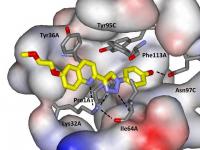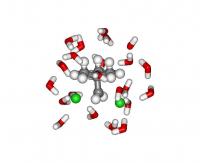William Jorgensen
Director, Division of Physical Sciences & Engineering, 2009-12
Member of Yale faculty since 1990
Research Interests
- Organic Chemistry
- Theoretical Chemistry
- Medicinal Chemistry
- Biophysical Chemistry
Research
Organic, medicinal, and computational chemistry including simulations of organic and enzymatic reactions, computer-aided drug design, and synthesis and development of therapeutic agents targeting infectious, inflammatory, and hyperproliferative diseases.
Computer-Aided Drug Discovery. Our approach features focused synthetic organic chemistry driven by state-of-the-art molecular design. The computations center on modeling protein-inhibitor complexes including docking for virtual  high-throughput screening, growing of combinatorial libraries inside binding sites with BOMB, and lead-optimization guided by Monte Carlo free-energy simulations. Synthesis and optimization of the most promising leads are performed in our laboratory; biological testing and crystallography are pursued either in our laboratory or with collaborators. The approach has allowed efficient discovery of extraordinarily potent anti-HIV, anti-inflammatory, and anti-cancer agents. Current protein targets include HIV-1 reverse transcriptase, CXCR4, MIF, parasitic TS-DHFRs, and JAK2 kinase.
high-throughput screening, growing of combinatorial libraries inside binding sites with BOMB, and lead-optimization guided by Monte Carlo free-energy simulations. Synthesis and optimization of the most promising leads are performed in our laboratory; biological testing and crystallography are pursued either in our laboratory or with collaborators. The approach has allowed efficient discovery of extraordinarily potent anti-HIV, anti-inflammatory, and anti-cancer agents. Current protein targets include HIV-1 reverse transcriptase, CXCR4, MIF, parasitic TS-DHFRs, and JAK2 kinase.
Modeling Organic Chemistry and Biochemistry in Solution. The group has pioneered computational studies of chemistry in solution, helping enable the widespread activities today in modeling or ganic and biomolecular systems. This includes development and application of the OPLS force fields and TIPnP water models, free-energy methods for organic reactions and host-guest binding, improved semiempirical MO methods, protein dynamics in water, and mixed quantum and molecular mechanics (QM/MM) simulations for organic and enzymatic reactions. Emphasis has been placed on elucidation of reaction mechanisms, transition states in solution, and the origin of medium effects on reaction rates. Multiple activities continue in developing improved methodology and force fields.
ganic and biomolecular systems. This includes development and application of the OPLS force fields and TIPnP water models, free-energy methods for organic reactions and host-guest binding, improved semiempirical MO methods, protein dynamics in water, and mixed quantum and molecular mechanics (QM/MM) simulations for organic and enzymatic reactions. Emphasis has been placed on elucidation of reaction mechanisms, transition states in solution, and the origin of medium effects on reaction rates. Multiple activities continue in developing improved methodology and force fields.
Education
A. B. Princeton University, 1970
Ph. D. Harvard University, 1975
Honors
A. C. Cope Scholar Award, 1990
Fellow, American Association for the Advancement of Science, 1994
ACS Award for Computers in Chemical and Pharmaceutical Research, 1998
Sato International Award, 2004
ISQBP Award in Computational Biology, 2004
Member, American Academy of Arts and Sciences, 2007
Fellow, American Chemical Society, 2009
Member, International Academy of Quantum Molecular Science, 2010
Member, National Academy of Sciences, 2011
ACS Joel H. Hildebrand Award in the Theoretical and Experimental Chemistry of Liquids, 2012
Tetrahedron Prize, 2015
Recent Publications
W. L. Jorgensen. Efficient Drug Lead Discovery and Optimization. Acc. Chem. Res. 2009, 42, 724-733.
O. Acevedo & W. L. Jorgensen. Advances in QM/MM Simulations for Organic and Enzymatic Reactions. Acc. Chem. Res. 2010, 43, 142-151.
P. Dziedzic, J. A. Cisneros, M. J. Robertson, A. A. Hare, N. E. Danford, R. H. G. Baxter & W. L. Jorgensen. Design, Synthesis, and Protein Crystallography of Biaryltriazoles as Potent Tautomerase Inhibitors of Macrophage Migration Inhibitory Factor. J. Am. Chem. Soc. 2015, 137, 2996-3003.
M. G. Robertson, J. Tirado-Rives & W. L. Jorgensen. Performance of Protein-Ligand Force Fields for the Flavodoxin - Flavin Mononucleotide Complex. J. Phys. Chem. Lett. 2016, 7, 3032-3036.
W. L. Jorgensen. Computer-Aided Discovery of Anti-HIV Agents. Bioorg. Med. Chem. 2016, 24, 4768-4788.